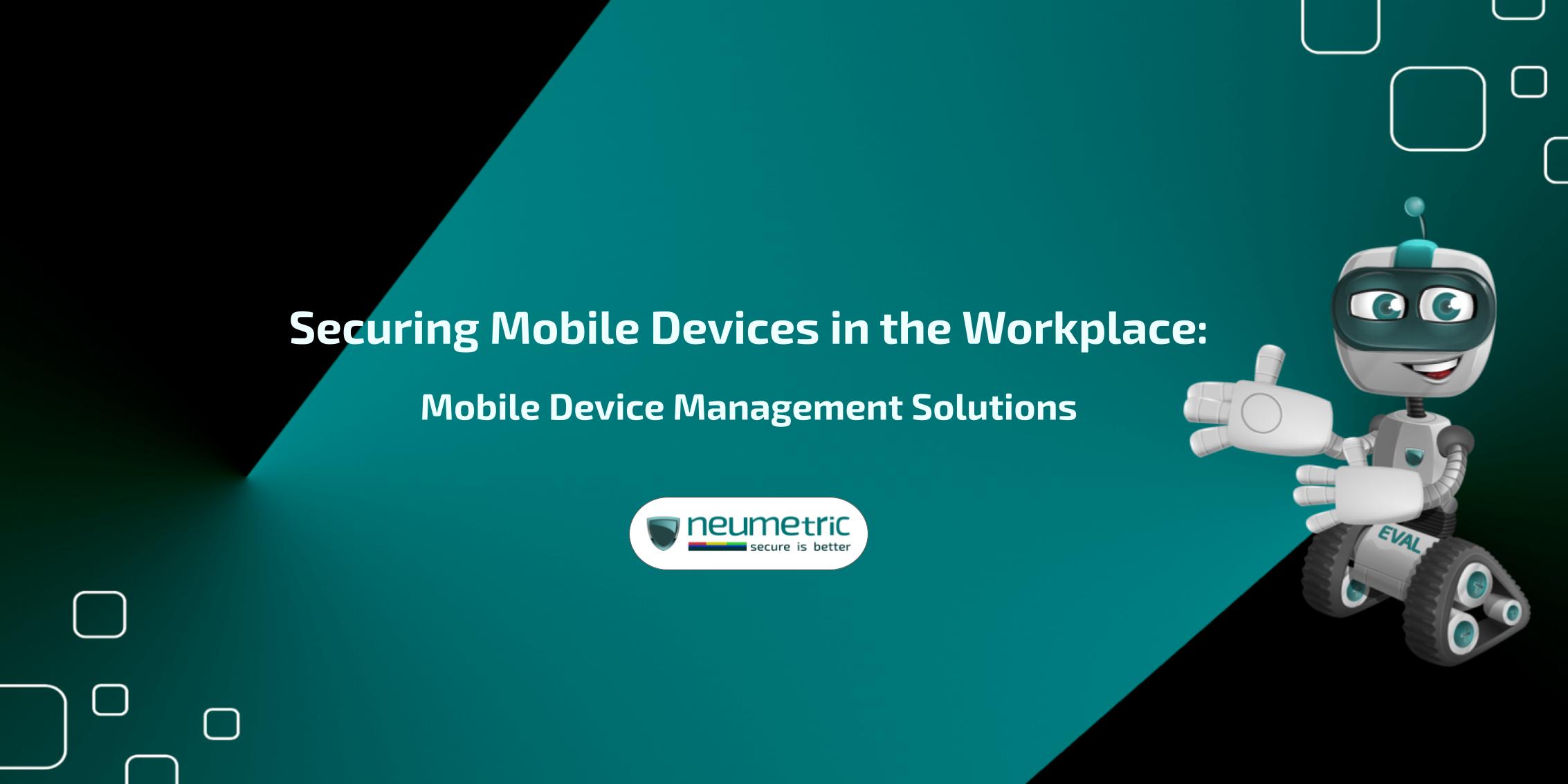Table of Contents
ToggleIntroduction
In this rapidly evolving landscape, understanding the role of mobile devices in the workplace is essential. They’re not just gadgets; they’re lifelines connecting employees, clients & partners across distances. However, with this increased reliance comes the pressing need for robust mobile device management [MDM] solutions to ensure security, compliance & efficiency. As organizations strive for greater flexibility & efficiency, the integration of smartphones, tablets & other mobile devices into daily operations has grown exponentially.
The adoption of mobile devices in businesses has seen a remarkable increase over the past decade. According to recent studies, approximately eighty seven percent (87%) of companies rely on their employees’ ability to access mobile business apps from their personal smartphones. BYOD policies are becoming increasingly popular, with sixty seven percent (67%) of employees using their personal devices at work. This trend not only enhances employee satisfaction & productivity but also presents unique challenges in terms of security & management.
Understanding Mobile Device Management [MDM]
To effectively secure mobile devices in the workplace, it is crucial to understand Mobile Device Management [MDM]. Mobile Device Management refers to the software solutions & strategies used by organizations to manage, secure & monitor mobile devices such as smartphones, tablets & laptops. The primary purpose of Mobile Device Management is to enhance the security of mobile devices, ensuring that sensitive corporate data remains protected while enabling employees to remain productive & connected.
Mobile Device Management [MDM] is a comprehensive approach to overseeing & securing mobile devices within an organization. Mobile Device Management solutions provide IT administrators with the tools & capabilities to remotely manage devices, enforce security policies & ensure compliance with corporate standards. By using Mobile Device Management, businesses can maintain control over the diverse range of devices & operating systems used by their employees, thereby mitigating risks associated with mobile device usage.
Objectives of Mobile Device Management Solutions
- Security Enforcement: Implementing security measures to protect sensitive data & prevent unauthorized access.
- Policy Compliance: Ensuring devices comply with corporate policies & regulatory requirements.
- Device Monitoring: Providing visibility into device usage & potential security threats.
- Remote Management: Enabling IT administrators to manage & troubleshoot devices remotely.
- Cost Efficiency: Reducing IT costs associated with managing & securing mobile devices.
Components of an Mobile Device Management System
Device Management: It involves the configuration & control of mobile devices within an organization. This includes:
- Automated Enrollment: Simplifying the process of enrolling devices into the Mobile Device Management system.
- Configuration Profiles: Setting up device settings, Wi-Fi configurations, email accounts & more.
- Policy Enforcement: Applying security policies such as password requirements & device encryption.
- Remote Control: Providing IT administrators with the ability to remotely lock, wipe or locate devices.
Application Management: It focuses on overseeing the applications installed on mobile devices. Key aspects include:
- App Distribution: Managing the deployment of business applications to devices.
- App Updates: Ensuring applications are kept up-to-date with the latest security patches & features.
- App Permissions: Controlling the permissions granted to applications, such as access to camera, contacts & location.
- Blacklisting & Whitelisting: Restricting or allowing specific applications to ensure compliance with corporate policies.
Content Management: Content management pertains to the control & distribution of corporate data on mobile devices. Important elements are:
- Secure File Sharing: Facilitating secure sharing of documents & files among employees.
- Data Encryption: Protecting data both at rest & in transit to prevent unauthorized access.
- Document Management: Managing access to corporate documents & ensuring they are up-to-date.
- Content Distribution: Distributing corporate content such as presentations, manuals & videos securely.
Security Management: Security management is a critical component of Mobile Device Management, focusing on protecting devices & data from threats. Key security measures include:
- Remote Wipe & Lock: Remotely erasing data or locking devices if they are lost or stolen.
- Threat Detection: Identifying & mitigating potential security threats such as malware or phishing attacks.
- Compliance Monitoring: Ensuring devices adhere to security policies & regulatory requirements.
- Access Control: Managing access to corporate networks & resources based on user roles & device status.
Key Features of Effective Mobile Device Management Solutions
Device Enrollment & Configuration
Effective Mobile Device Management solutions simplify the process of bringing new devices into the corporate environment & ensure they are properly configured from the start.
- Automated Enrollment Processes
- Streamlined device enrollment procedures reduce the burden on IT departments & ensure consistency.
- Supports various enrollment methods such as self-service portals, QR codes & email invites.
- Configuring Device Settings & Policies
- Allows IT administrators to push specific settings & configurations to devices, including Wi-Fi settings, VPN profiles & email accounts.
- Ensures compliance with corporate policies through the enforcement of security measures like password requirements & screen lock policies.
Application Management
Managing applications on mobile devices is critical to maintaining security & productivity.
- App Distribution & Updates
- Facilitates the deployment of both mandatory & optional applications to users’ devices.
- Ensures that all applications remain up-to-date with the latest features & security patches.
- Managing App Permissions & Security
- Controls which permissions are granted to applications, such as access to the camera, location & contacts.
- Uses whitelisting & blacklisting to manage which applications can be installed, ensuring compliance with corporate policies.
Security Enforcement
Security is a cornerstone of Mobile Device Management, protecting both devices & the sensitive data they contain.
- Remote Wipe & Lock Capabilities
- Provides the ability to remotely lock a device or erase its data if it is lost or stolen, preventing unauthorized access to corporate information.
- Encryption & Data Protection
- Ensures that data stored on mobile devices is encrypted, safeguarding it from unauthorized access.
- Implements data protection policies that secure sensitive information both at rest & in transit.
- Threat Detection & Response
- Identifies potential security threats such as malware, phishing attempts & unauthorized access attempts.
- Provides tools for responding to detected threats, including quarantine, isolation & remediation actions.
Monitoring & Reporting
Continuous monitoring & detailed reporting are essential for maintaining oversight & ensuring compliance.
- Real-Time Monitoring
- Offers real-time visibility into device status, compliance & potential security issues.
- Alerts IT administrators to non-compliant devices or those exhibiting unusual behavior.
- Reporting Tools & Analytics
- Generates detailed reports on device usage, application installations, compliance status & security incidents.
- Provides analytics that help in understanding trends, identifying areas of concern & making informed decisions.
Benefits of Implementing Mobile Device Management Solutions
Enhanced Security
Implementing Mobile Device Management solutions significantly strengthens the security posture of an organization by protecting sensitive data & mitigating risks associated with mobile devices.
- Protecting Sensitive Data
- Mobile Device Management solutions enforce encryption & data protection policies, ensuring that sensitive corporate information is safeguarded against unauthorized access.
- Secure access controls & authentication methods help prevent data breaches & unauthorized usage.
- Mitigating Risks of Lost or Stolen Devices
- Features like remote wipe & lock capabilities allow IT administrators to quickly secure or erase data from lost or stolen devices, minimizing the risk of data leakage.
- Location tracking & device monitoring help in recovering lost devices & preventing potential misuse.
Improved Compliance
Mobile Device Management solutions help organizations adhere to regulatory standards & simplify the audit process, ensuring that they remain compliant with industry-specific regulations.
- Ensuring Adherence to Regulatory Standards
- Mobile Device Management solutions enforce compliance with regulations such as GDPR, HIPAA & others by implementing required security measures & policies.
- Automated compliance checks & real-time monitoring ensure that devices consistently meet regulatory requirements.
- Simplifying Audit Processes
- Comprehensive reporting & documentation capabilities facilitate the audit process by providing detailed records of device usage, policy enforcement & security incidents.
- Centralized management of compliance data streamlines audit preparations & reduces administrative burden.
Increased Productivity
Mobile Device Management solutions enhance productivity by streamlining IT management & reducing technical issues, allowing employees to focus on their core tasks.
- Streamlining IT Management
- Automated device enrollment, configuration & updates reduce the time & effort required for IT administrators to manage mobile devices.
- Centralized control & management simplify the oversight of a large number of devices, enabling more efficient operations.
- Reducing Downtime & Technical Issues
- Proactive monitoring & real-time troubleshooting tools help quickly resolve technical issues, minimizing downtime & maintaining employee productivity.
- Regular updates & maintenance ensure devices are running optimally, reducing the likelihood of performance-related problems.
Cost Savings
Implementing Mobile Device Management solutions can lead to significant cost savings by reducing IT support costs & optimizing resource allocation.
- Reducing IT Support Costs
- Automation of routine tasks such as device enrollment, updates & policy enforcement reduces the need for manual intervention, lowering IT support costs.
- Remote management capabilities enable IT administrators to troubleshoot & resolve issues without the need for on-site visits, further cutting support expenses.
- Optimizing Resource Allocation
- Centralized management & monitoring allow organizations to allocate resources more effectively, focusing on areas that require immediate attention & optimizing overall IT operations.
- Improved device management reduces the frequency of device replacements & repairs, leading to lower hardware costs.
Challenges & Considerations
User Privacy Concerns
- Balancing Security & Privacy
- Striking a balance between securing corporate data & respecting employee privacy is crucial. Employees may be wary of excessive monitoring or data collection on their personal devices.
- Mobile Device Management solutions should clearly delineate between personal & corporate data, ensuring that personal information remains private.
- Strategies to Address Employee Concerns
- Transparent Communication: Clearly communicate the purpose & scope of Mobile Device Management policies to employees, explaining how their data will be protected.
- Privacy Policies: Implement privacy policies that specify what data will be monitored & how it will be used, ensuring transparency & building trust.
- Choose Privacy-Focused MDM Solutions: Opt for Mobile Device Management solutions that prioritize user privacy & offer features to segregate personal & work data.
Device Diversity
Managing a diverse array of devices & operating systems presents significant challenges for IT departments.
- Managing Multiple Operating Systems & Devices
- Organizations often need to support a variety of devices, including iOS, Android, Windows & macOS, each with its own set of management requirements.
- Ensuring consistent security & management across these diverse platforms can be complex & resource-intensive.
- Ensuring Compatibility & Support
- Cross-Platform Compatibility: Select MDM solutions that provide robust support for multiple operating systems & devices to ensure seamless management.
- Regular Updates: Ensure that the MDM solution receives regular updates to support new devices & operating system versions as they are released.
- Testing & Validation: Implement rigorous testing & validation processes to ensure compatibility & identify potential issues before deployment.
Scalability & Flexibility
MDM solutions must be scalable & flexible to accommodate the evolving needs of businesses.
- Adapting MDM Solutions to Changing Business Needs
- Businesses grow & change, requiring MDM solutions that can scale accordingly. An MDM solution should support both small teams & large enterprises, adapting to varying scales of operation.
- The ability to integrate with other business systems & adapt to new workflows & technologies is essential for long-term viability.
- Evaluating Scalability Features
- Cloud-Based Solutions: Consider cloud-based MDM solutions that offer inherent scalability & flexibility, allowing for easy adjustments based on organizational growth.
- Customizable Policies: Choose MDM solutions that allow for the creation of customizable policies & configurations to meet the unique needs of different business units or departments.
- Performance & Reliability: Ensure that the MDM solution can handle increasing numbers of devices without compromising on performance or reliability.
Best Practices for Securing Mobile Devices
Developing a Comprehensive MDM Strategy
A well-defined MDM strategy is essential for effectively securing mobile devices in the workplace.
- Assessing Business Requirements
- Understand the specific needs & objectives of your organization, considering factors such as industry regulations, workforce mobility & IT infrastructure.
- Conduct a thorough assessment of existing mobile device usage, security risks & management capabilities.
- Setting Clear Policies & Guidelines
- Establish clear & enforceable policies regarding device usage, data access & security practices.
- Define roles & responsibilities for employees, IT administrators & other stakeholders involved in the management of mobile devices.
Regularly Updating Software & Policies
Regular updates to software & policies are essential for maintaining the security & effectiveness of MDM solutions.
- Keeping Systems Up-to-Date
- Ensure that MDM software, applications & device firmware are regularly updated to address security vulnerabilities & performance issues.
- Implement automated update mechanisms to streamline the update process & minimize downtime.
- Regular Policy Reviews & Updates
- Conduct periodic reviews of MDM policies to assess their effectiveness & relevance in light of evolving threats & business requirements.
- Update policies as needed to address new security risks, regulatory changes & technological advancements.
Employee Training & Awareness
Educating employees on security practices & fostering a culture of security is critical for preventing security incidents & maintaining compliance.
- Educating Employees on Security Practices
- Provide comprehensive training on security best practices, including password hygiene, data encryption & device management.
- Offer ongoing education & awareness programs to keep employees informed about emerging threats & security trends.
- Promoting a Culture of Security
- Encourage employees to take ownership of their security responsibilities & report any suspicious activity or security incidents promptly.
- Recognize & reward employees who demonstrate exemplary security practices & contribute to maintaining a secure work environment.
Conclusion
Securing mobile devices in the workplace is paramount in today’s digital landscape, where the proliferation of smartphones, tablets & laptops presents both opportunities & challenges for organizations. Mobile Device Management [MDM] solutions play a crucial role in mitigating security risks, ensuring compliance with regulatory standards & enhancing productivity. By implementing comprehensive MDM strategies that encompass automated enrollment, application management, security enforcement & monitoring, businesses can effectively safeguard sensitive data & mitigate the risks associated with mobile device usage. Furthermore, fostering a culture of security through employee training & awareness initiatives is essential for creating a proactive approach to mobile device security, where employees are empowered to make informed decisions & play an active role in maintaining a secure work environment.
In conclusion, the benefits of implementing MDM solutions extend beyond security to encompass improved compliance, increased productivity & cost savings. However, organizations must also address challenges such as user privacy concerns, device diversity & scalability to ensure the success of their MDM initiatives. By following best practices such as regularly updating software & policies, developing clear guidelines & promoting a culture of security, businesses can navigate these challenges & reap the rewards of a secure & efficient mobile workforce. As technology continues to evolve, MDM solutions will remain essential tools for organizations seeking to harness the power of mobile devices while minimizing security risks & maximizing productivity.
Frequently Asked Questions [FAQ]
What is Mobile Device Management [MDM]?
MDM is a strategy to manage, secure & monitor mobile devices within an organization, ensuring compliance & protecting sensitive data.
Why is MDM important for businesses?
MDM enhances security, boosts productivity & reduces costs by centrally managing mobile devices & enforcing security policies.
What are the key features of effective MDM solutions?
Effective MDM solutions offer automated device enrollment, application management, security enforcement, real-time monitoring & reporting capabilities.
How can businesses address user privacy concerns with MDM?
Businesses can address privacy concerns by transparent communication, clear privacy policies & choosing MDM solutions that prioritize user privacy.
What are some challenges organizations may face when implementing MDM?
Challenges include managing device diversity, ensuring compatibility, adapting to changing business needs, balancing security & privacy & addressing employee resistance.





